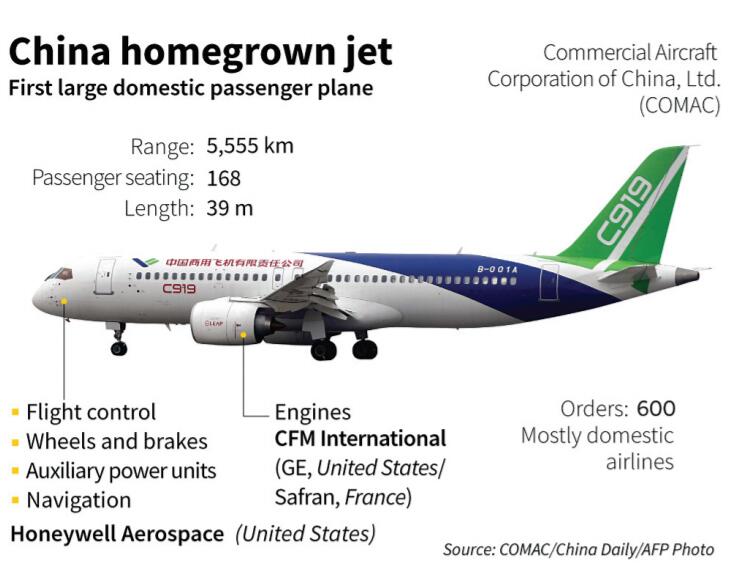Flight of passion takes off in style
 |
|
The C919, China's first large passenger airplane, lands at Shanghai Pudong International Airport after its maiden flight on May 5, 2017. XINHUA |
Executive vice-president of French engine specialists Safran talks about how 'proud and excited' he was to work on China's first large passenger jet, the C919
Olivier Dubroeucq reads Chinese classical literature to settle himself and find inner calm.
The Frenchman has a lot to be excited about-not least the global debut of the LEAP-1C engine, which powered the maiden flight of the country's first large passenger aircraft, the C919.
"I'm very excited, very proud," said Dubroeucq, executive vice-president of the COMAC & AVIC program of Safran.
"Proud of Safran being a partner of COMAC. Proud of China's aviation industry. And proud of myself," he added.
COMAC is the Commercial Aircraft Corporation of China Ltd, which built the C919, and Safran SA is a leading aerospace engine and equipment manufacturer.
It made the LEAP-1C engines and the outer layer nacelles for the aircraft through CFM International, a 50-50 joint venture between Safran Aircraft Engines and General Electric.
"You can see a new giant of the global aviation industry," Dubroeucq said. "China is moving forward with major steps such as the successful flight of the C919."
The maiden flight on May 5 was a crucial test of both the aircraft as a whole and its propulsion system.
Dubroeucq and his team witnessed the historical event at Shanghai Pudong International Airport.
"China demonstrated its independent pursuit of mastering key technologies in large passenger aircraft manufacturing," he said. "It has also created valuable opportunities in global aviation."
More than 200 enterprises in 22 provinces and cities in China took part in the research and development of the C919. Up to 16 leading international aviation companies were selected as airborne system suppliers, with 16 joint ventures set up.
The LEAP engine family integrates cutting-edge technologies of Safran subsidiaries and global giant General Electric. It includes the LEAP-1A adopted by the Airbus A320neo, the LEAP-1B on the Boeing 737MAX, and the LEAP-1C used by COMAC.
The three have similarities in performance and components. But the main difference lies in electrical and mechanical interfaces, and the engine's appearance, which is adapted to the aircraft design.
"The LEAP-1C has excellent environmental performance, with significant reductions in energy consumption, gas emissions and noise, making the C919 competitive with its peer models," Dubroeucq said.
Indeed, the spring of 2017 will be remembered as the time China finally realized the development of a homegrown large passenger aircraft.
This reflected the country's determination to master the key technologies, matching the status of a major power.
For Dubroeucq, it was a great honor to start to work with China in 2014, directly participating in the development of the C919 as the integrated propulsion system program director.
"I like doing intricate and difficult things," he said. "The more difficult, the more my potential is stimulated.
"If providing engines for a type of newly developed aircraft was one such thing, the other was learning Chinese," he added.
Dubroeucq took out a copy of The Great Learning, a Confucian classic on governance, and chanted word-by-word. The Chinese classics can "enlighten and calm" him during tight business schedules and trips. "The Chinese characters are so complicated and difficult, similar to an aero-engine," he said. "The more you achieve, the happier and prouder you get."

The C919 project has taken two decades, but it has helped trigger an acceleration in the global aviation industry.
The LEAP-1C engine and nacelle, for example, are innovative designs that are lighter and easier to maintain than current propulsion systems.
"The innovation also lies in its adoption of an integrated propulsion system, including the engine, nacelle and all relative modules," Dubroeucq said.
The C919's first flight also marked the launch of an O-type ducted thrust reverser designed by Safran Nacelles.
"Competitive design and technologies are just the beginning," Dubroeucq said. "The major challenge stays to win market trust from their safe, reliable and efficient operation."
If the C919 is to compete against aircraft from Airbus SE, the giant European aerospace company, and Boeing Co, the United States-based corporation, it must be on the same level of technology.
"That's exactly what COMAC did by choosing the LEAP engine . . . They're on the right track," Dubroeucq said.
The C919 still faces major challenges such as the time for its market launch, its operational performance and reliability, as well as brand image building to get customers.
"Time will give trust and reliability," Dubroeucq said. "Safran has gained a global reputation in one century, and we would like to share our experience with China."
According to him, the Safran team is now eyeing a more challenging and larger aircraft that will be jointly developed by the world's second biggest economy and Russia.
China is the world's second largest aviation market and is growing fast. Safran plans to strengthen its cooperation with China's aviation industry through joint ventures and production subcontracting with major Chinese aviation industry partners.
"We are not working in a short term in China," Dubroeucq said. "The market is here and we are right here. All we have done is to pave the way to share the future."









